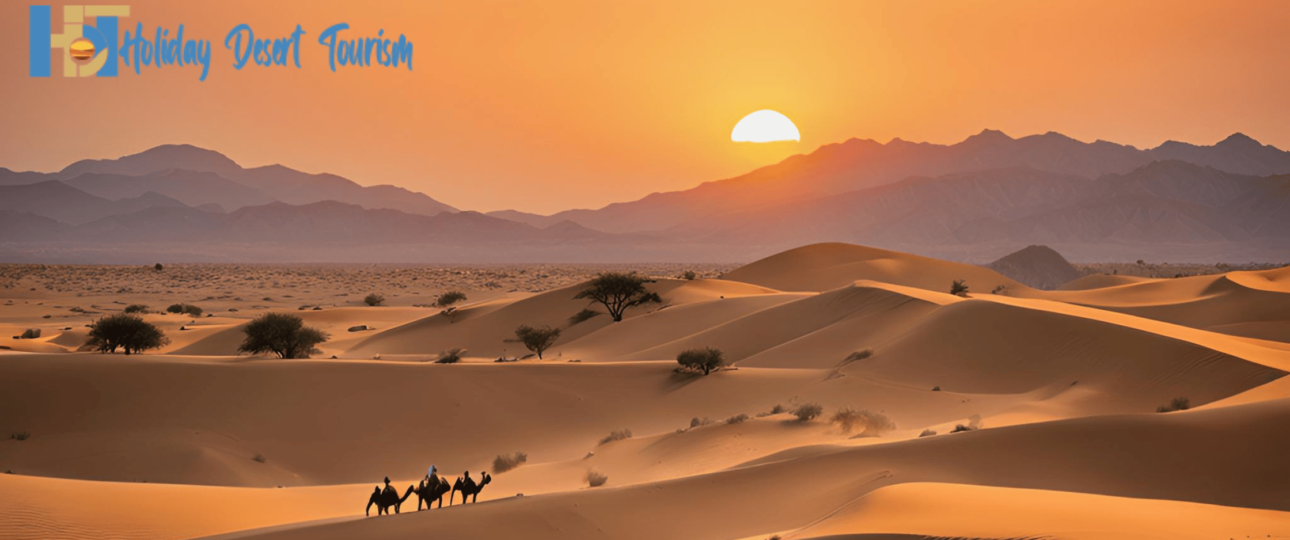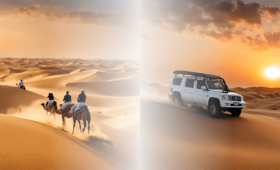A desert safari is a photographer’s paradise, offering endless opportunities to capture breathtaking landscapes, wildlife, and the cultural richness of the desert. Whether you’re using a professional DSLR, a mirrorless camera, or even a smartphone, with the right approach, you can master Desert Safari Photography and create images that reflect the beauty and spirit of the desert. In this guide, we’ll explore expert tips and tricks to help you capture stunning photos during your desert safari adventure.
Best Time for Desert Safari Photography: The Golden Hour
Why Golden Hour is Crucial for Stunning Desert Shots
The best time for Desert Safari Photography is during the golden hour — right after sunrise or just before sunset. The soft, warm light during these times adds a magical glow to your photos, enhancing the natural beauty of the desert. Golden hour light brings out the rich colors of the sand, highlights textures in the dunes, and creates long shadows that add depth and dimension.
Golden Hour Benefits:
-
- Soft, warm light that creates a gentle glow.
- Dramatic lighting that adds texture to dunes.
- Beautiful colors in the sky and landscape.
Choosing the Right Gear for Desert Safari Photography
DSLR vs. Mirrorless Cameras for Desert Photography
When it comes to capturing the essence of a desert safari, selecting the right camera gear is crucial. Both DSLR and mirrorless cameras are excellent choices for Desert Safari Photography, but each has its pros and cons.
- DSLR Cameras:
- Longer battery life.
- Robust and durable for harsh conditions.
- Mirrorless Cameras:
- Lighter and more portable for easy travel.
- High-quality images with advanced features.
Essential Lenses for Capturing Desert Landscapes
To truly showcase the desert’s beauty, a variety of lenses can help you create stunning photographs:
- Wide-Angle Lens (16-35mm): Perfect for capturing expansive landscapes and vast sand dunes.
- Telephoto Lens (70-200mm): Ideal for photographing distant wildlife, such as camels or desert foxes.
- Prime Lenses (50mm): Great for portraits and capturing the intricate details of desert plants or textures.
Mastering Composition in Desert Safari Photography
How to Create Compelling Photos Using the Desert’s Natural Features
In Desert Safari Photography, composition plays a significant role in turning a simple image into something stunning. The desert’s vast landscape offers opportunities to play with light, shadows, and textures. Here are some tips:
- Leading Lines in the Dunes: Use the natural curves of sand dunes as leading lines to guide the viewer’s eye through the frame.
- Use of Shadows: Experiment with the long shadows created by the low angle of the sun to add drama to your shots.
- Balance with Foreground Objects: Include a subject or object in the foreground to add depth and scale to your composition.
Wildlife Photography Tips for the Desert
Patience and Preparation for Capturing Desert Wildlife
A Desert Safari Photography session is incomplete without capturing the desert’s elusive wildlife. From camels to desert foxes, the desert is teeming with life, though the animals can be shy. Patience is key!
- Animals to Photograph:
- Camels: Majestic and symbolic of desert life.
- Desert Foxes: Small, elusive, and often active during twilight.
- Birds: Eagles, vultures, and other desert birds make fascinating subjects.
Respecting Wildlife During Your Shoot
When photographing wildlife, always maintain a safe distance. Use a telephoto lens to capture detailed images without disturbing the animals. Avoid using flash photography, as it can startle the animals.
Photographing the Desert Landscape: Dunes, Sand, and Sky
How to Capture the Majestic Sand Dunes
Sand dunes are the signature feature of any desert, and photographing them is a highlight of Desert Safari Photography. Here’s how to make the most of the dunes:
- Capture the Curves: Use the natural lines of the dunes to create flowing compositions that lead the eye.
- Shoot at Golden Hour: As mentioned earlier, golden hour light enhances the texture and depth of the dunes, making for powerful and dramatic shots.
The Sky’s Role in Desert Photography
The desert sky is vast and offers a perfect backdrop for your photos. Whether it’s the deep blue of midday or the warm colors during sunset, don’t forget to incorporate the sky in your compositions.
- Wide-Angle Lens: Ideal for capturing both the dunes and the expansive sky.
- Use of Gradients: Look for color transitions in the sky during sunrise or sunset for added visual interest.
Portrait Photography in the Desert
Capturing Humans and Culture in the Desert
Desert safaris aren’t just about landscapes; they also offer an opportunity to capture the local culture and people. Desert Safari Photography can tell powerful stories of human life in the desert. Here are a few tips for taking portraits in the desert:
- Golden Hour Portraits: The soft, warm light during golden hour makes for perfect portraits. The desert’s backdrop enhances the subject’s features.
- Incorporate the Surroundings: A camel ride, the vast dunes, or even desert plants can make for a compelling portrait setting.
Respecting Local Culture in Your Photos
Before taking photos of local people, always ask for permission. Some desert communities prefer not to be photographed. Approach individuals respectfully and be mindful of their cultural values.
Dealing with Desert Photography Challenges
Protecting Your Gear from Desert Conditions
Desert environments can be tough on camera gear. The sand can damage lenses and sensitive equipment, so take extra precautions.
- Use Protective Covers: Ensure your gear is protected from dust and sand.
- Dustproof Bags: Store your camera in dustproof bags when not in use.
How to Stay Cool and Comfortable During Your Safari
Desert safaris can be intense, with high temperatures and little shade. Stay hydrated and protect yourself from the heat while capturing photos. Here’s how:
- Wear Protective Clothing: Loose, breathable clothing protects you from the sun.
- Keep Equipment Cool: Avoid leaving your camera under the sun for prolonged periods to prevent overheating.
Conclusion:
Capturing stunning photos on a desert safari is all about preparation, patience, and the right techniques. With the golden hour light, the right gear, and a keen eye for composition, you can document the magic of the desert and create images that will last a lifetime. Whether you’re photographing the vast sand dunes, elusive wildlife, or the local culture, Desert Safari Photography offers limitless opportunities to explore and create.
FAQs
What is the best time to take photos on a desert safari?
The golden hour — shortly after sunrise and before sunset — provides the best lighting for Desert Safari Photography, offering warm and soft light.
Which camera gear is best for desert photography?
A DSLR or mirrorless camera with a wide-angle lens, telephoto lens, and tripod is ideal for capturing landscapes and wildlife during a desert safari.
How do I protect my camera gear in the desert?
Use dustproof bags, protective covers, and avoid changing lenses in sandy conditions to keep your equipment safe.
Can I photograph desert wildlife?
Yes, but patience is key. Use a telephoto lens to keep a safe distance from wildlife and avoid disturbing them.
How do I photograph desert dunes?
Shoot during the golden hour to capture dramatic light and shadows on the dunes, emphasizing texture and form.




